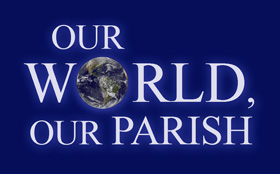Key points:
- Connectionalism has always been an essential part of what it means to be Methodist.
- Recent divisions in The United Methodist Church have raised a host of questions about the meaning of connectionalism, particularly as some congregations leave.
- As current forms of connection change, our theological understanding of connectionalism may need to change also.


Photo © Hector Amador.
Commentaries
Connectionalism is a fundamental part of what it means to be church for Methodists.
But recent divisions in and separations from The United Methodist Church have raised a host of questions about the meaning of connectionalism: If some people and churches leave The United Methodist Church, are they still “in connection” with United Methodists? If so, in what way? If The United Methodist Church has connectional relationships with other Methodist denominations such as the AME Church, could it develop similar relationships with the Global Methodist Church? What about churches that leave The United Methodist Church to become independent? Are they still connectional, or have they lost something distinctly Methodist?
To begin answering such questions, one must look at the many possible meanings of connectionalism. Methodists have varied ways in which they connect with one another and with other Christians. These varied ways include organizational, relational and theological dimensions of connectionalism.
Connectionalism as organization
For many, the term “connectionalism” brings to mind denominational structures. Indeed, denominational structures are one of the most important ways that United Methodists connect to one another. Nevertheless, the concept of denomination is a modern one and one that is understood differently in different parts of the world.
Methodists connected to one another before our current denominational structures and connect with others outside those structures as well. Thinking of connectionalism in terms of denominational structures and, more broadly, in terms of organizational linkages highlights several important forms of connectionalism.
First, it emphasizes the important link between connectionalism and conferencing. In John Wesley’s days, the “connexion” was those preachers who conferenced with Wesley. Connectionalism was defined by conferencing. Since Wesley’s days, various forms of conferencing – from local charge conferences to General Conference to the World Methodist Conference – have continued to be important means for Methodists to connect with one another.
Yet the varying levels of conference also highlight the complexity of connectionalism as defined by organizational connections. Two United Methodists in Minnesota may have a fairly direct connection because they are part of the same General Conference, jurisdictional conference and annual conference. A United Methodist in Alabama and one in Angola would be connected less directly by the General Conference but would also be separated by central/jurisdictional conference and annual conference (in addition to language and culture!). Moreover, both the United Methodist in Alabama and the one in Angola would be in some sense connected to a Methodist in Argentina through the World Methodist Conference, even though they were in separate denominations. Within and beyond The United Methodist Church, conferencing both connects and distinguishes varying groups of Methodists.
Mentioning Argentinian Methodists raises the question of inter-denominational connectionalism. Indeed, The United Methodist Church as a whole has a variety of bilateral and multilateral connections with other denominations. Here again, variety proliferates. There are at least five different forms of bilateral interdenominational connection alone (concordat, affiliated autonomous, affiliated united, covenanting and full communion). The United Methodist Church is part of many multilateral ecumenical groups, including the World Methodist Council.
Moreover, the different levels of conferencing and variety of inter-denominational connectionalism can intersect to produce an exponentially greater number of possible forms of connection within and beyond Methodism. Many central conferences and annual conferences have direct ecumenical relationships with other church bodies, either bilaterally or multilaterally. United Methodists in Wisconsin are bilaterally connected to Methodists in Bolivia, and United Methodists in the Democratic Republic of Congo are connected to many other denominations through that country’s council of churches.
Organizational connections abound even further at the local level. A United Methodist congregation may be connected to an AME congregation (along with Lutherans, Baptists, Church of God in Christ and others) through a local ministerial association or through a joint agreement to support a particular social ministry. The variety of such local forms of organizational connectionalism are beyond counting.
What characterizes all this dizzying array of organizational connectionalism within and beyond Methodism is formal agreements among those organizations. Such arrangements make the rules, rights and responsibilities involved in organizational connections clear. Put another way, organizational connection includes explicit agreements about joint decision-making, finances, programming, accountability, etc.
These sorts of organizational connections are the ones that are most directly being changed when individuals and churches leave The United Methodist Church. Changes in organizational status raise questions about the rules, rights and responsibilities that had previously held. It is clear that those leaving The United Methodist Church will not have the same rights and responsibilities in the denomination as they previously had — nor will they be bound by the same rules. It remains a significant open question what, if any, new forms of organizational connections (out of the many possible forms on many possible levels) will come to exist among those remaining United Methodist and those formerly in the church.
Connectionalism as relationship
While organizational forms of connection within and beyond The United Methodist Church as a denomination are important, they are far from the only way Methodists connect. As I have written about with regard to European Methodism, personal relationships can be just as central to how Methodists connect with one another as formal organizational ties.
Here again, roots of a relational understanding of connection can be traced back to John Wesley. The earliest Methodist conferences were not formal organizations but rather gatherings of people that had personal relationships with Wesley. Developing Methodist organization grew out of pre-existing relationships among Wesley and the early Methodist preachers and class leaders.
The first conferences were not only relational but focused specifically on conversation. Thinking of connection in terms of communities of conversation remains relevant today. Whether those conversations happen via social media, scholarly discourse or official ecumenical dialogue, participating in conversations about what it means to be Methodist is one of the things that makes someone Methodist and part of the Methodist connection.
Of course, Methodists are not focused just on talking; they are people who believe that one’s faith should be lived out in one’s actions. Thus, another important way in which Methodists connect relationally is by collaborating in mission and ministry.
Sometimes this collaboration can take the form of formal, organizational connections. But there are countless examples of informal collaboration among Methodists within and beyond The United Methodist Church that are based on the personal connections of those involved in the work, not on a formal organizational contract. Such informal collaborative connections are especially important at the local level, where Methodists work with one another and others to run soup kitchens, carry out evangelistic campaigns, lobby for policies and share discipleship resources.
A deterioration in such interpersonal, relational connections has both preceded and precipitated the current breaking of organizational connectional ties. Breaking such organizational ties will continue to rend personal connections. Indeed, much of the angst that people feel over the severing of organizational connections is driven by concerns for what that will mean for relationships.
Connectionalism as theological principle
Formal organizational ties and interpersonal relationships are concrete and tangible expressions of connectionalism. But behind these practices of connectionalism lie theological understandings of connectionalism. A theological understanding of connectionalism affirms that the true nature of the church must include the bonds among congregations. This view contrasts with a congregational understanding of the church, in which each congregation is by itself fully the church. A belief in connectionalism is connected to beliefs about the unity of the church and the catholicity of the church.
Some of the concern about the present denominational division within The United Methodist Church is a theological concern for what this division expresses about our belief in or realization of the unity of the church. This concern is fair. Yet as a theological principle, concepts like the unity of the church and connectionalism are not dependent upon human practices but rather rooted in the divine will. All Christians are connected to one another by their mutual connection to Christ, whether we recognize those connections or not and however well (or poorly) we live them out.
Shifting senses of connectionalism
As I have indicated above, the current denominational division has raised questions about organizational, relational and theological understandings of connectionalism. In particular, shifting organizational and relational connections are deeply intertwined. A breakdown in relational connections makes an organizational separation easier to contemplate, which has further implications for relationships.
A theological view of connectionalism can either be a source of anxiety or reassurance amid these fracturing organizational and relational connections. We must also take seriously the possibility that as organizational and relational forms of connectionalism are reconfigured, this may shift theological understandings of connectionalism.
As United Methodists and Global Methodists grapple with how to relate to one another, either directly, indirectly (through common participation in multilateral groups like the World Methodist Council), and programmatically (through common use of Wespath services, for instance), how will these new forms of practical organizational and relational connectionalism lead to new insights about or changed interpretations of connectionalism as a theological principle?
For Methodists within and beyond The United Methodist Church, fidelity to the Methodist tradition demands that we grapple with such questions.
Scott is the director of mission theology in the Office of the General Secretary at United Methodist Global Ministries.
News contact: Joey Butler or Tim Tanton at (615) 742-5470 or [email protected]. To read more United Methodist news, subscribe to the free Daily or Friday (weekly) Digests.
Like what you're reading? Support the ministry of UM News! Your support ensures the latest denominational news, dynamic stories and informative articles will continue to connect our global community. Make a tax-deductible donation at ResourceUMC.org/GiveUMCom.



